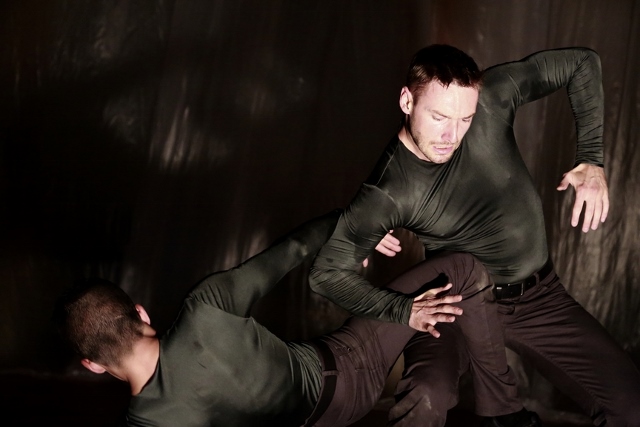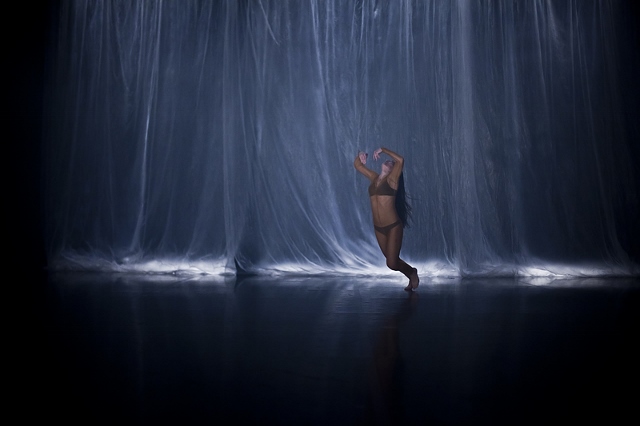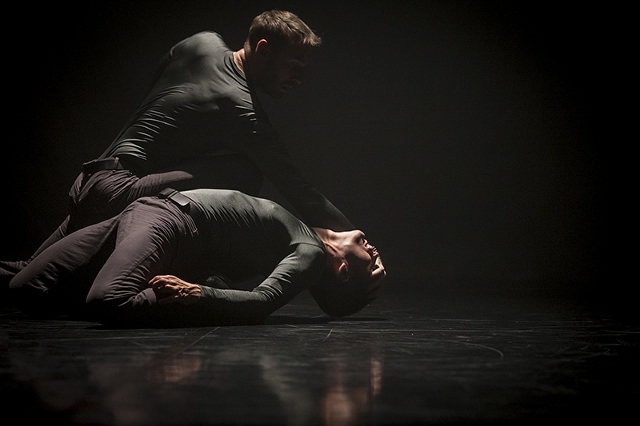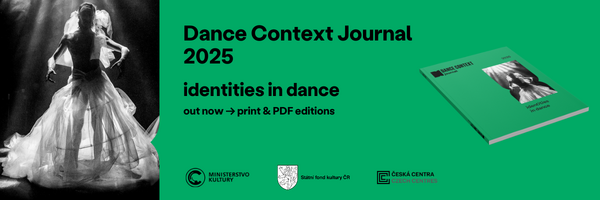Diptych Twice Seen
 The content is clear and its fulfilment is a challenge for all participants. The music for the piece was composed by the Italian Carlo Natoli, the visual side, including light design, was prepared by Jan Komárek. But the final result was ambivalent and it seemed too vague at both premieres.
While Radek Bohata is still looking for his original approach to the role, Michal Záhora’s performance is convincing. His stage presence is now more mature, he has stepped out of his comfort zone, has abandoned familiar dance vocabulary and started to explore new ways of movement expression. However, he is not able to fully imagine his large-scaled vision, despite all the improvements realized between the two runs.
The first part dispensed with the backdrop video projection as its function was obviously not clear, though it formed the foundation of the whole visual side. It did not do the duet any good, anyway. Drawing the audience’s attention to the dancing helped to intensify the mutual relations of the dancers, it added suspension and make the whole opening part more compact. However, it still lacked dynamism and energy, including the rhythmical aspects of the dance expression. It was not obvious if such effect was caused by dance performances or the choreographic work itself, or if there was ano
ther reason. Carlo Natoli wrapped the melodious piano music into sound effects which were rather a burden than support for the dancers. It showed inscrutably in the second part, in which the solo dancer had only music and light for partners. Suddenly, we strongly missed the lancet arch of the eastern wall of St. Anne’s chapel which, unfortunately, was not compensated in the scenography more than it was necessary in terms of practical purposes (window frame for installing the contra spotlight used in the finale). The attention of the public was thus fully concentrated on the dancer, rather ineffectively. Dagmar Chaloupková was gradually locking herself into her own story and her own world. Only the light design helped the audience understand her dance expression, her mime and gestures, which became more concrete through her inner transformation, but their motivations remained hazy.
The content is clear and its fulfilment is a challenge for all participants. The music for the piece was composed by the Italian Carlo Natoli, the visual side, including light design, was prepared by Jan Komárek. But the final result was ambivalent and it seemed too vague at both premieres.
While Radek Bohata is still looking for his original approach to the role, Michal Záhora’s performance is convincing. His stage presence is now more mature, he has stepped out of his comfort zone, has abandoned familiar dance vocabulary and started to explore new ways of movement expression. However, he is not able to fully imagine his large-scaled vision, despite all the improvements realized between the two runs.
The first part dispensed with the backdrop video projection as its function was obviously not clear, though it formed the foundation of the whole visual side. It did not do the duet any good, anyway. Drawing the audience’s attention to the dancing helped to intensify the mutual relations of the dancers, it added suspension and make the whole opening part more compact. However, it still lacked dynamism and energy, including the rhythmical aspects of the dance expression. It was not obvious if such effect was caused by dance performances or the choreographic work itself, or if there was ano
ther reason. Carlo Natoli wrapped the melodious piano music into sound effects which were rather a burden than support for the dancers. It showed inscrutably in the second part, in which the solo dancer had only music and light for partners. Suddenly, we strongly missed the lancet arch of the eastern wall of St. Anne’s chapel which, unfortunately, was not compensated in the scenography more than it was necessary in terms of practical purposes (window frame for installing the contra spotlight used in the finale). The attention of the public was thus fully concentrated on the dancer, rather ineffectively. Dagmar Chaloupková was gradually locking herself into her own story and her own world. Only the light design helped the audience understand her dance expression, her mime and gestures, which became more concrete through her inner transformation, but their motivations remained hazy.
 More than the effort to be on the same wavelength with the dancer, both premieres in Nečtiny and Prague evoked memories of the solo of maiden Uliana from Bohuslav Martinů’s Kytice, presented in September at the Malá Strana Cemetery in Prague (choreography Eva Blažíčková), in which Dagmar Chaloupková perfectly embodied everything the role required, surely thanks to Martinů’s timeless and ingenious music.
The longing, tempted, tested, regretting and resignedly atoning fragility is the essence of her ethereal solo part in Diptych, too, though in a different context. But something was missing or redundant - maybe the costume, a combination of a transparent nude nylon unitard and plainblack women’s underwear. It flattered the dancer’s beautiful body, but within the concept of the piece it seemed over-combined. The similarly “unsuccessful” element was the reproduced voice at the beginning and the end of the first part. It would have sounded better live, for sure, without the taste of pathos and with more humanity.
It is absolutely obvious that the endless circle of maturing (as described by the authors of the piece), be it any kind of maturing, has its phases consisting of certain cycles and gained life experience. When many such phases go by, we are finally able to look back on the specific point in time and understand it and also understand ourselves. However, Michal Záhora’s choreography reflects the recent times, almost the present, and we can only doubt that its cycle has been completed. In layman's terms, he and other performers in the piece (except for Jan Komárek) are too young for such a subject and for the theme of depersonalisation. They are not inexperienced
More than the effort to be on the same wavelength with the dancer, both premieres in Nečtiny and Prague evoked memories of the solo of maiden Uliana from Bohuslav Martinů’s Kytice, presented in September at the Malá Strana Cemetery in Prague (choreography Eva Blažíčková), in which Dagmar Chaloupková perfectly embodied everything the role required, surely thanks to Martinů’s timeless and ingenious music.
The longing, tempted, tested, regretting and resignedly atoning fragility is the essence of her ethereal solo part in Diptych, too, though in a different context. But something was missing or redundant - maybe the costume, a combination of a transparent nude nylon unitard and plainblack women’s underwear. It flattered the dancer’s beautiful body, but within the concept of the piece it seemed over-combined. The similarly “unsuccessful” element was the reproduced voice at the beginning and the end of the first part. It would have sounded better live, for sure, without the taste of pathos and with more humanity.
It is absolutely obvious that the endless circle of maturing (as described by the authors of the piece), be it any kind of maturing, has its phases consisting of certain cycles and gained life experience. When many such phases go by, we are finally able to look back on the specific point in time and understand it and also understand ourselves. However, Michal Záhora’s choreography reflects the recent times, almost the present, and we can only doubt that its cycle has been completed. In layman's terms, he and other performers in the piece (except for Jan Komárek) are too young for such a subject and for the theme of depersonalisation. They are not inexperienced
 or immature, just too young. Diptych belongs to productions that need more time to reach their final, fixed form, which - provided there is the right constellation - can turn into a fatal impulse. Like Orbis Pictus (choreography by Michal Záhora and Lenka Bartůňková) or Flashed by (choreography by Lenka Flory), Diptych requires the audience’s empathy, as it explores the deepest corners of the human soul. Not everybody is allowed to look into the human soul and not everybody really likes it. But those who are able to appreciate the values of this choreographic style can discover another dimension of the human existence and its sense.
Written from both premieres, on 16 October 2014 in St. Anne’s Chapel in Nečtiny near Pilsen and on 29 October 2014 in the Ponec Theatre, Prague.
Diptych
Subject and choreography: Michal Záhora
Creation and dance: Dagmar Chaloupková, Radek Bohata a Michal Záhora
or immature, just too young. Diptych belongs to productions that need more time to reach their final, fixed form, which - provided there is the right constellation - can turn into a fatal impulse. Like Orbis Pictus (choreography by Michal Záhora and Lenka Bartůňková) or Flashed by (choreography by Lenka Flory), Diptych requires the audience’s empathy, as it explores the deepest corners of the human soul. Not everybody is allowed to look into the human soul and not everybody really likes it. But those who are able to appreciate the values of this choreographic style can discover another dimension of the human existence and its sense.
Written from both premieres, on 16 October 2014 in St. Anne’s Chapel in Nečtiny near Pilsen and on 29 October 2014 in the Ponec Theatre, Prague.
Diptych
Subject and choreography: Michal Záhora
Creation and dance: Dagmar Chaloupková, Radek Bohata a Michal ZáhoraMusic: Carlo Natoli
Scenography, light design and photo: Jan Komárek
Costumes: creative collective
Costume design and realisation: Pavel Křivánek
Production: Honza Malík & NANOHACH, z. s. First premiere: 17 October 2014, sv. Anne’s Chapel, Nečtiny
Second premiere: 27 October 2014, Ponec Theatre, Prague Translation: Tereza Cigánková


